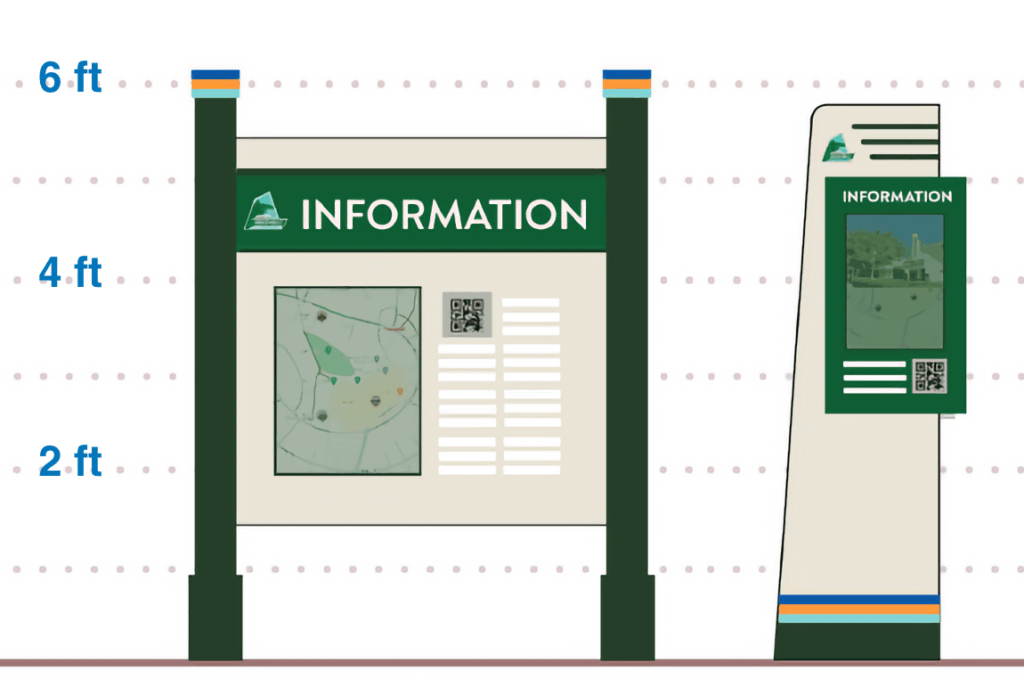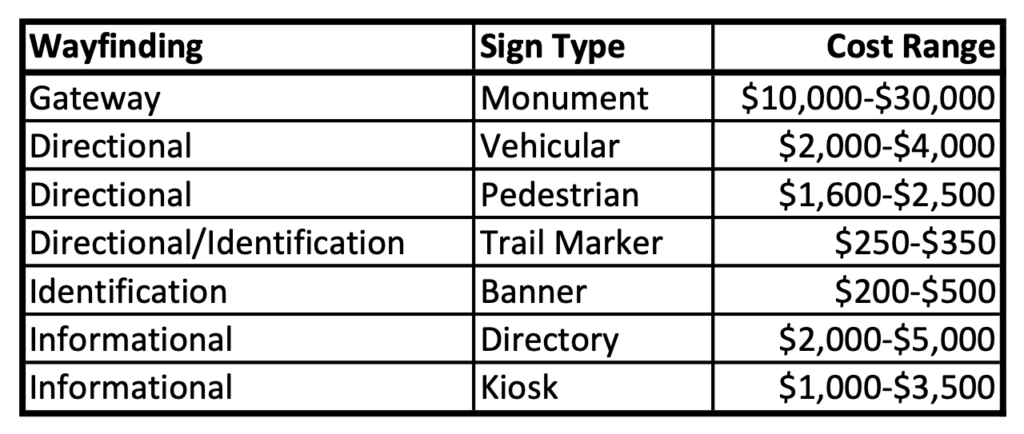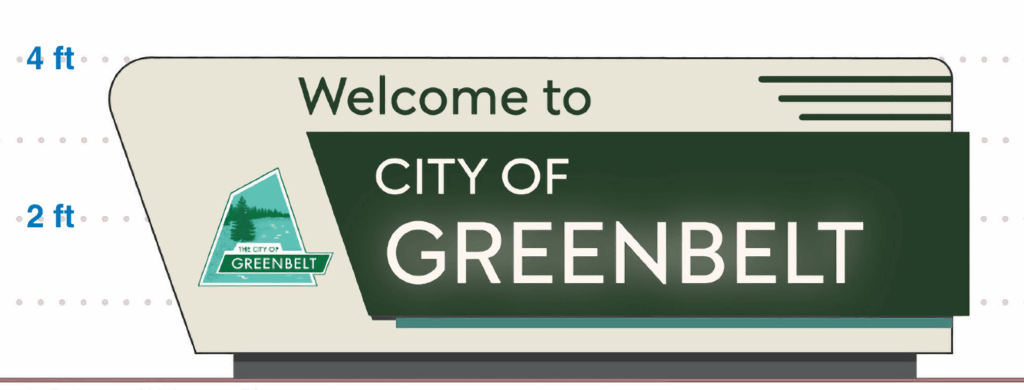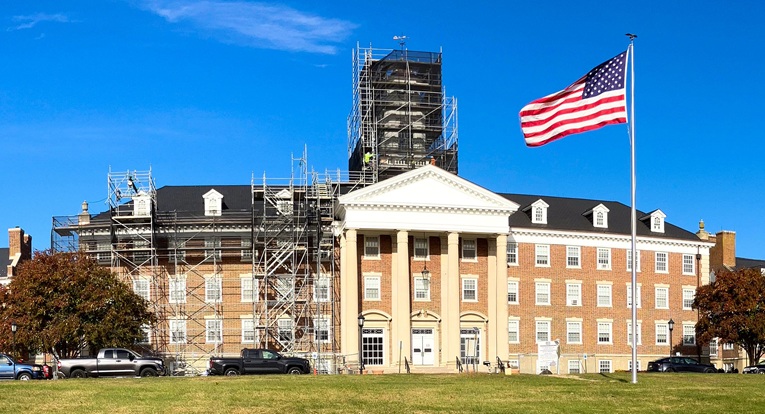On September 17, Greenbelt City Council held a worksession to discuss a draft of the city’s new wayfinding plan that aims to use directional, place-identifying and welcoming signs to create a cohesive city identity.
The city’s Assistant Director of Planning, Jaime Fearer, shared a presentation of the final draft plan, which she said staff had been actively working on for 18 months. A community survey was carried out from December 2023 to January 2024, which yielded 179 responses, according to Fearer. A draft outline was previously presented to council (see page 6 of the January 2, 2025, issue). Fearer described the current presentation as the final draft report, and she expected to take any final comments back to groups and consultants before bringing the plan back to council for approval. The strategic wayfinding plan is authored by the Maryland-National Capital Park and Planning Commission and the Prince George’s County Planning Department. The City of Greenbelt applied to the county planning department’s Planning Assistance to Municipalities and Communities Program in December 2021 to fund a strategic wayfinding plan for the city. Following approval in May 2022, the project kicked off in January 2023.
“I just want to remind folks these are conceptual; anything that comes from this will have to go into further design, which will be an implementation cost,” said Fearer at the start of the presentation.
Types of Signs
The plan aims to improve navigation for residents and visitors, and enhance Greenbelt’s sense of place. It includes gateway signs, like the one on Southway, directional signs for cars, bikes and pedestrians and informational signage. The city plans to also include banners, trail markers, informational kiosks and directories. Currently, signs exist in the city, but vary in quality, the way information is presented, ownership and material, said Fearer at the meeting.
Costs
The signs can be expensive, and one sign that welcomes visitors to Greenbelt can cost up to $30,000. The recent gateway sign on Southway was funded by a $50,000 grant with approximately $30,000 in matching money from the city. However, “it is important to note that a significant portion of the costs weren’t related to the cast stone sign itself, but rather to the demolition and reconstruction of the sitting wall at that location,” Fearer noted.
The draft plan calls for the addition of five new gateway signs, as well as other forms of signage throughout the city. Looking at a table of costs that ranged as high as $30,000 for a gateway sign and $2,000 to $4,000 for a vehicular directional sign, Jordan asked if they were aggregate costs or for individual signs and was told the latter, and he jokingly asked if they could make them hollow.
In addition to the cost of the signs, the installation costs are estimated to run an additional 35 to 50 percent of the materials cost, lighting to be another $1,500 to $5,000 and the design, permitting and engineering fees to be 10 to 20 percent of the total project cost. Councilmember Silke Pope asked if installation could be done in-house rather than contracted out and Fearer responded that it might be possible for some of the banners, for example, but they didn’t yet know to that level of detail.
AAB Recommendation
Amanda Larsen of the Arts Advisory Board (AAB) said that their board recommends that a graphic designer be hired to go beyond the concept stage and give consideration to the architecture of Greenbelt while also considering the clarity of the signs. Larsen also noted that the AAB was interested in bringing more visibility to the arts in Greenbelt, and to venues such as the Cinema.

Scaling Back
Jordan urged staff to research alternative materials and suggested materials like carbon fiber and epoxy resin. “There are a lot of different materials that have been developed … that are just as durable as concrete … that could be used that are a lot lighter and would last a significant amount of time,” Jordan said.
Councilmember Kristen Weaver also recognized the project’s cost and stressed the importance of intentional spending. Greenbelt doesn’t just have to worry about the upfront costs of these signs, but also the long-term maintenance and replacement schedule, said Weaver. “We need to be careful to think about all of the costs in our decisions,” Weaver said. “There’s the cost of the sign, but there’s also the cost of … does this sign have more maintenance in the future? Can it be done in-house, or is it someone else that has to take care of it?”
Councilmember Rodney Roberts questioned the necessity of numerous signs, given that people use the GPS systems in their cars and on their phones nowadays to get to their destinations. “Maybe we don’t need to put in a couple million dollars’ worth of signs,” he said.
Phased Implementation
Asked about the total costs of the project, Fearer told the News Review: “The plan doesn’t outline a total cost estimate in part because final costs will vary depending on multiple factors, including materials, installation, site preparation, signage complexity, regulatory requirements, design and consulting fees, project management and labor costs and maintenance. The city also anticipates implementing the proposed wayfinding in a phased manner, as outlined in the plan. Each sign type can be designed and installed independently based on funding availability and city priorities, and if funding becomes available for specific elements, those can be installed as standalone projects while still conforming to the overall wayfinding plan.”

Funding
“The city does not currently have funding earmarked for implementation of the wayfinding plan,” Fearer told the News Review. “As mentioned in the plan, the city will explore a number of funding opportunities, including federal, state, local and philanthropic grants.”
Potential sources of funding for this project, as cited in the draft, include federal monies and grants such as the Department of Transportation’s Transportation Alternatives Program, Maryland Heritage Areas Authority Grants, the Maryland Department of Housing and Community Development’s Community Legacy Program and the Federal Highway Administration’s Recreation Trails Program. There is also the possibility of funding from Prince George’s County Regional Development Authority and public-private partnerships, according to the presentation at the worksession. The final draft of the plan is expected to be completed in February 2026, according to a previous city council work session agenda.
Ashna Balroop is a University of Maryland student at the Philip Merrill College of Journalism writing for the Greenbelt News Review.




